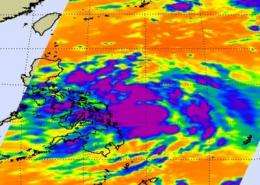NASA infrared satellite imagery shows Tropical Storm Mawar strengthening

The infrared instrument on NASA's Aqua satellite captured temperature data on Tropical Storm Mawar in the western North Pacific Ocean and showed that the cloud top temperatures were growing colder. That's an indication that the thunderstorms within are higher and stronger - a sign of strengthening.
By June 1, 2012 at 1500 UTC (10 a.m. EDT), System 95W organized into Tropical Storm Mawar. It had maximum sustained winds near 35 knots (40 mph/65 kph) at that time. It was located about 245 nautical miles east-northeast of Manila, Philippines, near 15.9 North and 124.9 East. It was moving to the northeast at 8 knots (9 mph/14.8 kph) and generating 13-foot (3.9 meter) high waves.
When NASA's Aqua satellite passed overhead, data from the Atmospheric Infrared Sounder (AIRS) gathered infrared data. The image showed improved deep convection (rising air that form the thunderstorms that make up the tropical storm) wrapping into its low-level circulation center.
The AIRS images show the temperature of the cloud tops or the surface of the Earth in cloud-free regions. The coldest cloud temperatures are located around Mawar's center. Those areas have some of the strongest storms. Scientists use the AIRS data to create an accurate 3-D map of atmospheric temperature, water vapor and clouds, all of which are helpful to forecasters. AIRS' infrared signal doesn't penetrate through clouds. Where there are no clouds the AIRS instrument reads the infrared signal from the surface of the ocean waters, revealing warmer temperatures in orange and red.
Forecasters expect Mawar is going to follow a boomerang-shaped path in the western North Pacific, and its outer bands may just graze the east coast of Luzon, Philippines. The main threat from 04W is rough surf along the east-facing coasts of the Philippines over the next several days. By June 4, Mawar is forecast to reach typhoon strength with maximum sustained winds near 85 knots (98 mph/157.4 kph) before weakening.
On June 4 and 5, it is expected to bring rainfall and rough surf to Kadena, southern Japan, Iwo To and Chichi Jima but is expected to weaken by June 5 due to increased wind shear and cooler water temperatures.
Provided by NASA's Goddard Space Flight Center



















